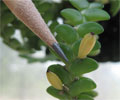|
|
|
|
|
| |
Established Seedlings of
Angraecum distichum 'Buenaventura' × self |
|
| |
|
|
| |
| Number: |
TN7397 |
| Name: |
Angraecum distichum 'Buenaventura' × self
|
| Type: |
self (What's that?) |
|
Seed Donor: |
Kelly Williams
|
|
Click to Enlarge

Pod Parent Flower |
Click to Enlarge

Pod Parent Blooming Plant |
Click to Enlarge

Pod Parent Capsules at 196 days |
|
|
|
| |
For additional origin/habitat information supplied courtesy of
Charles and Margaret Baker, see further below, near the bottom of this page.
|
Temperatures we attempt to use in the lab & greenhouse:
| For Species: |
|
Spring, Summer, Autumn, Winter: days average 81°F, nights 71°F; best fit is Warm-Intermediate 87-64°F
(Source:
Baker's Web OSC) |
|
About the name...
| Etymology of |
Angraecum |
|
From latinized Malay "anggurek" an orchid that has a vanda-like appearance.
(Source:
Mayr & Schmucker 1998) |
| Etymology of |
distichum |
|
From Latin "distichus" distichous, in two rows.
(Source:
Mayr & Schmucker 1998) |
| Pronunciation of |
Angraecum |
|
an-GRY-kum
(Source:
Hawkes 1978) |
| Pronunciation of |
distichum |
|
DIS-ti-kum
(Source:
Hawkes 1978) |
|
If you would like to direct someone to this web page, please copy and paste this URL into your email:
http://troymeyers.com/d?127397
|
ESTABLISHED SEEDLINGS
of these are not currently available, but we have some maturing in the greenhouse and expect to offer them in the future.
There are 0 items with
plants per
item that will be considered for sale later.
Click here to see if we have flasks available.
|
|
|
| |
The origin/habitat information below is supplied courtesy of Charles and Margaret Baker
The following information is based on the name of the plant provided by the donor, and assumes that the name is correct. If the plant has been misidentified, then the following information may not be correct.
This text is copyrighted by the Bakers and may not be reproduced without permission.
ORIGIN/HABITAT: Africa. In equatorial west Africa, Angraecum distichum is
found in the coastal countries of Guinea and Sierra Leone eastward through
Liberia, Ivory Coast, Ghana, Nigeria, Cameroon, then southward to Angola.
Distribution extends eastward through the interior to western Uganda.
Although many collections are reported, only a few include habitat
elevation, and those that did were all at or below 650 ft. (200 m).
More about this information and the Bakers...
|
|
|
| |
|
|
|